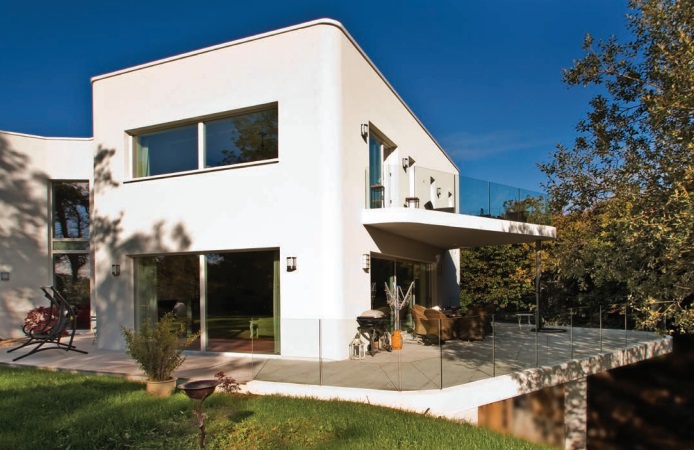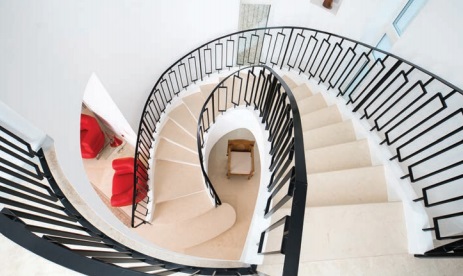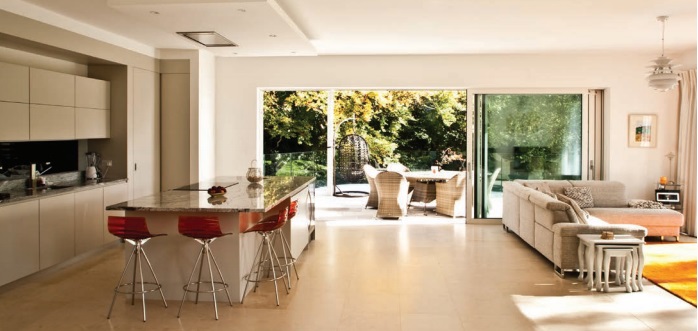Streamline House
In 2016, the winner of the Alan King Award for Excellence in Architectural Technology was Streamline House. Brian Davies MCIAT and Mark Davies MCIAT of Arc Design look back at the project.
The client’s existing house was a thermally efficient 2000 standard timber frame dormer bungalow. The clients wanted planning permission to sub-divide their 1.1-acre site and construct a new modern ‘A’-rated house for themselves. Once planning permission had been granted, they would sell their existing house to finance the new build project.
Fortunately, the site was relatively level, however the intended location of the new house was very close to a fast-flowing stream with banking along the eastern boundary, which we took advantage of within our building design.
The brief was to design a unique modern art deco-influenced house as a retirement home. The house with its subtle curves takes advantage of the natural curvature of the stream whilst incorporating the soft sound of water rushing underneath the overhanging balcony, with a view towards an existing secret garden.
The internal ground floor accommodation includes a large open plan living/dining/kitchen space, utility room, separate lounge room and a spectacular curved staircase leading to the first floor. The first floor comprises of a master suite with access to the balcony overlooking the stream, three additional bedrooms, one with en suite and a family bathroom. It was important for our clients to have a uniquely designed house with an energy efficient building fabric and a renewable heating system giving low annual running costs.
As the design team, we evaluated the best approach to construct the building, which incorporated external curves with large areas of glazing, internal open plan layouts and cantilevered balconies. We decided to use an insulated concrete formwork (ICF) walling system, connected to reinforced concrete floors, balconies and curved feature staircase. All floors, balconies and staircase are finished in polished Italian marble. A full heat recovery system was concealed within the ceilings and connected to a heat exchanger unit.
It was essential for the house to achieve sustainable performance along with a comfortable all year round living environment. ICF construction provides a high level of thermal insulation and air tightness (air permeability rating resulting in excellent low annual energy running costs), by combining CFC/HCFC free insulation and concrete thermal mass, minimises temperature fluctuations by absorbing and storing heat. The complete building envelope is thermally designed to approximately 25% above the minimum Irish Building Regulation Standards.
The monolithic concrete building construction was designed to be extremely resilient to flood damage, and incorporated low maintenance components and finishes. Triple glazed AluClad windows and door units were fitted. The house is fitted with a sophisticated Mechanical Heat Recovery Ventilation System (MVHR) supplying fresh air to all habitable rooms. A sustainable electric solution for the heating and hot water was provided to work alongside the MVHR. A water source heat pump was located in the stream providing heat energy to the house all year round.
The hot water and under floor heating was provided via a water source heat pump with an open loop system using stream water which passes into an underground concrete holding tank to raise the temperature of water to the required minimum of eight degrees. Stream water enters the heat pump through the heat exchanger; the heat is removed and disbursed throughout the house through under floor heating pipes. The used water is then dumped back into the stream without any contamination, making the system environmentally friendly.
ICF walling system is seen to be the most user friendly, due to its innovative design, which increases speed of construction, reduces labour costs and provides the highest level of performance during and after construction. Purity of the external design was paramount so exposed external rainwater downpipes were eliminated. Drainage from the balconies were concealed within the vertical hollow structural steel supports.
The local stream water temperature was deemed ideal for using the water source heat pump providing sustainable efficient hot water and heating throughout the year. We incorporated the Amvic ICF system, awarded an A+ by the BRE under its Green Guide to Specification assessment scheme. The A+ demonstrated that the ICF system was one of the most environmental friendly and sustainable ways to build. A sustainable wood burning appliance was incorporated into the formal lounge and relaxation area.
The site is level and the building is fully accessible and compliant under the Irish Building Regulations. The external cantilevered balconies incorporate an adjustable raised pedestal system allowing occupants level access from the building interior.
This article was originally published in AT ed. 122.
--CIAT
[edit] Related articles on Designing Buildings Wiki
Featured articles and news
Government consultations for the summer of 2025
A year of Labour, past and present consultations on the environment, the built environment, training and tax.
CMA competitiveness probe of major housing developers
100 million affordable housing contributions committed with further consultation published.
Homes England supports Greencore Homes
42 new build affordable sustainable homes in Oxfordshire.
Zero carbon social housing: unlocking brownfield potential
Seven ZEDpod strategies for brownfield housing success.
CIOB report; a blueprint for SDGs and the built environment
Pairing the Sustainable Development Goals with projects.
Types, tests, standards and fires relating to external cladding
Brief descriptions with an extensive list of fires for review.
Latest Build UK Building Safety Regime explainer published
Key elements in one short, now updated document.
UKGBC launch the UK Climate Resilience Roadmap
First guidance of its kind on direct climate impacts for the built environment and how it can adapt.
CLC Health, Safety and Wellbeing Strategy 2025
Launched by the Minister for Industry to look at fatalities on site, improving mental health and other issues.
One of the most impressive Victorian architects. Book review.
Common Assessment Standard now with building safety
New CAS update now includes mandatory building safety questions.
RTPI leader to become new CIOB Chief Executive Officer
Dr Victoria Hills MRTPI, FICE to take over after Caroline Gumble’s departure.
Social and affordable housing, a long term plan for delivery
The “Delivering a Decade of Renewal for Social and Affordable Housing” strategy sets out future path.
A change to adoptive architecture
Effects of global weather warming on architectural detailing, material choice and human interaction.
The proposed publicly owned and backed subsidiary of Homes England, to facilitate new homes.
How big is the problem and what can we do to mitigate the effects?
Overheating guidance and tools for building designers
A number of cool guides to help with the heat.
The UK's Modern Industrial Strategy: A 10 year plan
Previous consultation criticism, current key elements and general support with some persisting reservations.
Building Safety Regulator reforms
New roles, new staff and a new fast track service pave the way for a single construction regulator.




























